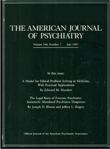Psychotic Episode Associated With Dexfenfluramine
Mr. A was a white, 48-year-old man with major depression. He had a history of alcohol and cannabis abuse but had been sober and drug free for 2 years. He had never experienced major depression until 1 year earlier, at which time he experienced feelings of hopelessness, impaired concentration, and severe fatigue. He also gained more than 35 pounds within several months. He was placed on a regimen of doxepin, 200 mg/day, to which he responded well, without any side effects. Two months before admission to our unit, Mr. A's primary care physician had placed him on a regimen of dexfenfluramine, 30 mg/day, for treatment of obesity after several unsuccessful dieting attempts. Although he initially experienced insomnia for about 2 weeks, Mr. A's sleep pattern eventually had returned to normal.
On the day that Mr. A was admitted to the psychiatric emergency room, he had become increasingly paranoid. He blamed family members and the government for taking part in a conspiracy against him and the citizens of the United States. He eventually walked into a federal building in the neighborhood and asked to see the visitor's log. When his request was denied by the security personnel, he became violent. Mr. A's extreme agitation and combativeness at the time of admission necessitated the use of four-point restraints. He was responding to internal stimuli and blaming the medical staff for being a part of the conspiracy against him. He had pressured speech and exhibited grandiose and paranoid delusions, e.g., “I knew the truth about what happened to that airplane.” He responded well to a 5-mg intramuscular dose of droperidol that was administered shortly after admission. A urine toxicology screen and a blood alcohol test revealed that no alcohol or illicit drugs had been ingested. No electrolyte imbalance was determined from routine laboratory tests. There was no history of psychotic disorder in the family. Mr. A was given intramuscular haloperidol, 2 mg b.i.d., during the subsequent 24 hours of his hospital stay. He was discharged, and his symptoms resolved completely within 72 hours after dexfenfluramine discontinuation. He was able to go back to work within a week.
References
Information & Authors
Information
Published In
History
Authors
Metrics & Citations
Metrics
Citations
Export Citations
If you have the appropriate software installed, you can download article citation data to the citation manager of your choice. Simply select your manager software from the list below and click Download.
For more information or tips please see 'Downloading to a citation manager' in the Help menu.
View Options
View options
PDF/EPUB
View PDF/EPUBGet Access
Login options
Already a subscriber? Access your subscription through your login credentials or your institution for full access to this article.
Personal login Institutional Login Open Athens loginNot a subscriber?
PsychiatryOnline subscription options offer access to the DSM-5-TR® library, books, journals, CME, and patient resources. This all-in-one virtual library provides psychiatrists and mental health professionals with key resources for diagnosis, treatment, research, and professional development.
Need more help? PsychiatryOnline Customer Service may be reached by emailing [email protected] or by calling 800-368-5777 (in the U.S.) or 703-907-7322 (outside the U.S.).

